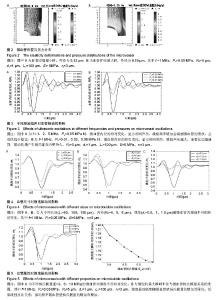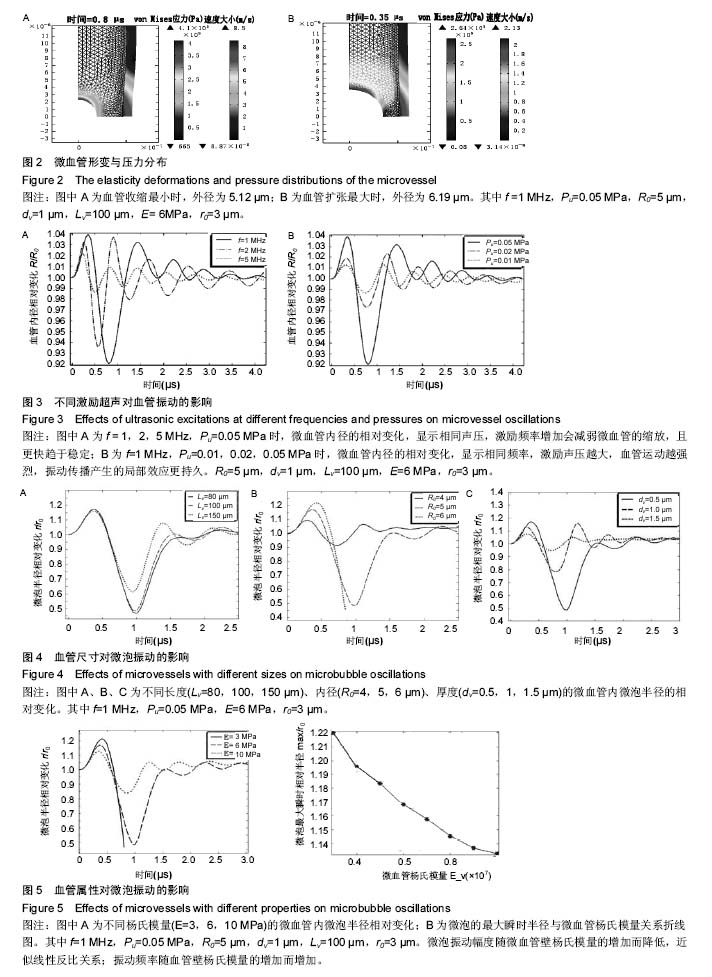Chinese Journal of Tissue Engineering Research ›› 2016, Vol. 20 ›› Issue (42): 6330-6336.doi: 10.3969/j.issn.2095-4344.2016.42.015
Previous Articles Next Articles
Simulation of acoustic response of microvessel containing microbubble in ultrasound field based on finite element analysis and lumped parameter model
Niu Chuan-xiao, Guo Sheng-wen, Qiu Lin, Lao Yong-hua, Jiang Xing-jun
- School of Material Science and Engineering, South China University of Technology, Guangzhou 510006, Guangdong Province, China
-
Received:2016-08-08Online:2016-10-14Published:2016-10-14 -
Contact:Guo Sheng-wen, Professor, School of Material Science and Engineering, South China University of Technology, Guangzhou 510006, Guangdong Province, China -
About author:Niu Chuan-xiao, Master, School of Material Science and Engineering, South China University of Technology, Guangzhou 510006, Guangdong Province, China -
Supported by:the National Natural Science Foundation of China, No. 31371008, No. 81171179; the Science and Technology Plan of Guangdong Province, No. 2015A02024006
CLC Number:
Cite this article
Niu Chuan-xiao, Guo Sheng-wen, Qiu Lin, Lao Yong-hua, Jiang Xing-jun. Simulation of acoustic response of microvessel containing microbubble in ultrasound field based on finite element analysis and lumped parameter model[J]. Chinese Journal of Tissue Engineering Research, 2016, 20(42): 6330-6336.
share this article

2.1 血管和微泡响应的形变、血压变化及血管应力分布 模型仿真得图2血管和微泡响应过程中的形变,血压变化及血管应力分布结果。微泡在超声激励下振动,影响周围血液流动,从而引起血管壁发生规律的弹性形变,交替收缩和扩张,图中血管壁形变的最小、最大外径分别为5.62 μm、6.19 μm。可见,微泡径向运动因受近处血管壁面限制,移动速度较轴向小;而血管壁因与微泡振动耦合,近微泡的中心处位移和应力最大。 2.2 激励超声对血管振动的影响 图3模拟不同声压(Pu=0.01,0.02,0.05 MPa)和频率(f=1,2,5 MHz)超声对微血管振动的影响。图3A显示相同声压,激励频率增加会减弱微血管的缩放,且更快趋于稳定;图3B显示相同频率,激励声压越大,血管运动越强烈,振动传播产生的局部效应更持久。 2.3 血管尺寸对微泡振动的影响 图4显示当f=1 MHz,Pu=0.05 MPa时,不同长度(Lv=80,100,150 μm)、内径(R0=4,5,6μm)、厚度(dv = 0.5,1,1.5 μm)的微血管,对半径为3 μm的微泡振动的影响。可见,管长的增长加大了对微泡的限制作用,且足够的长度能缓解沿血管传播的振动对微泡产生的二次激励[29],因此微泡振动频率增加且振幅减小,与文献[14]中的仿真结果和文献[9,11-12]中的实验结果相符。当血管半径增大到6 μm以上时,血管限制作用低于该组模型参数的合理范围,微泡振动剧烈,半径急剧减小至破裂[30]。此外,血管内径和厚度的增加,均会使微泡振动频率、振幅减小。当血管壁趋于无限厚时,二者的耦合机制减弱,相当于刚性壁面的限制作用。 2.4 血管属性对微泡振动的影响 由图5可知,微泡振动幅度随微血管壁杨氏模量的增加而降低,近似线性反比关系;振动频率随血管壁杨氏模量的增加而增加,结果与Martynov等[14]的发现一致。当血管杨氏模量减小到3 MPa以下时,微血管弹性超出该组模型参数的合理范围,微泡急剧缩小至破裂[30]。"

| [1] Miller DL,Williams AR,Morris JE,et al. Sonoporation of erythrocytes by lithotripter shockwaves in vitro. Ultrasonics.1998;36(9):947-952. [2] Hynynen K,McDannold N,Vykhodtseva N,et al. Noninvasive MR imaging-guided focal opening of the blood-brain barrier in rabbits.Radiology.2001; 220(3): 640-646. [3] Meairs S,Alonso A.Ultrasound,microbubbles and the blood-brain barrier.Prog. Biophys Mol Biol.2007;93: 354-362. [4] Martynov S,Stride E,Saffari N.The natural frequencies of microbubble oscillation in elastic vessels . The Journal of the Acoustical Society of America, 2009; 126(6): 2963. [5] Stride E,Pancholi K,Edirisinghe MJ,et al.Increasing the nonlinear character of microbubble oscillations at low acoustic pressures.J R Soc Interface.2008;24:807-811. [6] 郭维,刘光达,焦阳,等.基于脉搏波信号和血管弹性腔模型的动脉血压连续测量方法[J]. 生物医用力学,2012,27(1): 85. [7] Morgan KE,Allen JS,Dayton PA,et al.Experimental and theoretical evaluation of microbubble behavior: Effect of transmitted phase and bubble size.IEEE Trans Ultrason Ferroelectr Freq Control.2000;47(6): 1494-1509. [8] Allen JS,May DJ,Ferrara KW.Dynamics of therapeutic ultrasound contrast agents. Ultrasound Med Biol.2002;28(6):805-816. [9] Sassaroli E,Hynynen K.Resonance frequency of microbubbles in small blood vessels: a numerical study.Phys Med Biol.2005;50(22):5293-5305. [10] Plesset MS,Prosperetti A.Bubble dynamics and cavitation. Ann Rev Fluid Mech.1977;9: 145-185. [11] Caskey CF,Kruse DE,Dayton PA,et al.Microbubble oscillation in tubes with diameters of 12, 25, and 195 microns.Appl Phys Lett.2006;88(3):033902. [12] Caskey CF,Kruse DE,Dayton P,et al.On the oscillations of microbubbles in tubes with diameters as small as 12 microns[C]//Ultrasonics Symposium,2005 IEEE.IEEE, 2005; 2: 854-857. [13] Qin S,Ferrara KW.The natural frequency of nonlinear oscillation of ultrasound contrast agents in microvessels.Ultrasound Med Biol.2007;33:1140-1148. [14] Martynov S,Stride E,Saffari N.The natural frequencies of microbubble oscillation in elastic vessels.J Acoust Soc Am.2009;126:2963-2972. [15] Doinikov AA,Aired L,Bouakaz A.Modeling and experiments on the far-field scattering .J Fr Ophtalmol. 2010;36(15):1133-1136. [16] Doinikov AA,Novell A,Bouakaz A.Dynamics of a Contrast Microbubble Between Two Elastic Walls.2012 IEEE International Ultrasonics Symposium. 2012;31: 654-662. [17] Wiedemair W,Tukovi? ?,Jasak H,et al.On ultrasound-induced microbubble oscillation in a capillary blood vessel and its implications for the blood-brain barrier.Phys Med Biol.2012;57(4): 1020-1024. [18] Hosseinkhah N,Hynynen K.A three-dimensional model of an ultrasound contrast agent gas bubble and its mechanical.Phys Med Biol.2012;57(3):785-808. [19] de Jong N,Cornet R,Lancee CT.Higher harmonics of vibrating gas-filled microspheres: part 1. Simulation. Ultrasonics.1994;32(6):447-453. [20] de Jong N,Cornet R,Lancee CT.Higher harmonics of vibrating gas-filled microspheres: part 2: Measurements.Ultrasonics.1994;32(6):455-459. [21] Paul S,Katiyar A,Sarkar K,et al.Material characterization of the encapsulation of an ultrasound contrast microbubble and its subharmonic response: strain-softening interfacial model.J Acoust Soc Am. 2010;127(6):3846-3850. [22] Li Q,Matula TJ,Tu J,et al.Modeling complicated rheological behaviors in encapsulating shells of lipid-coated microbubbles accounting for nonlinear changes of both shell viscosity and elasticity.Phys Med Biol.2013;58(4):985-998. [23] 程茜,钱梦騄.超声微泡造影剂的低频动力学行为[J].声学技术,2006,25(4):292-298. [24] 邱晓晖,沈圆圆,钱建庭,等.刚性微管内微泡动力学行为的有限元数值分析[J].生物医学工程学杂志,2011,28(5): 911-915. [25] Shen YY,Wang TF,Diao X,et al.Numerical analysis of interaction between microbubble and elastic microvessel in low frequency ultrasound field using fluid solid interaction method [C].Biomedical and Health Informatics (BHI),2012 IEEE-EMBS International Conference on IEEE,2012:733-736. [26] VanBavel E.Effects of shear stress on endothelial cells: possible relevance for ultrasound applications.Prog Biophys Mol Biol.2007;93:374-383. [27] Mukundakrishnan K,Ayyaswamy PS,Eckmann DM.Bubble motion in a blood vessel: shear stress induced endothelial cell injury.Biomech Eng.2009; 131:074516. [28] Qin S,Ferrara KW.Acoustic response of compliable microvessels containing ultrasound contrast agents. Phys Med Biol.2006;51(20):5065. [29] Sergey M,Erik K,Nader S,et al.Forced vibration of a bubble in a liquid-filled elastic vessel.J Acoust Soc Am.2012;130(5):2700-2708. [30] Shen YY,Wang TF,Chin CT,et al.Interaction between microbubble and elastic microvessel in low frequency ultrasound field using finite element method. Chin Sci Bull.2013;58(3):291-298. [31] Oishi Y,Kakimoto T,Yuan W,et al.Fetal Gene Therapy for Ornithine Transcarbamylase Deficiency by Intrahepatic Plasmid DNA-Micro-Bubble Injection Combined with Hepatic Ultrasound Insonation. Ultrasound Med Biol.2016;42(6):1357-1361. [32] Wang G,Zhang Q,Zhuo Z,et al.Enhanced Homing of CXCR-4 Modified Bone Marrow-Derived Mesenchymal Stem Cells to Acute Kidney Injury Tissues by Micro- Bubble-Mediated Ultrasound Exposure. Ultrasound Med Biol.2016;42(2):539-548. [33] Sajjadi B,Raman AA,Ibrahim S.Influence of ultrasound power on acoustic streaming and micro-bubbles formations in a low frequency sono-reactor: mathematical and 3D computational simulation. Ultrason Sonochem.2015;24:193-203. [34] Chiu AH,Haluszkiewicz E,McAuliffe W.Micro-bubble transcranial Doppler ultrasound for exclusion of right-to-left circulatory shunts: why should we provide the service?J Med Imaging Radiat Oncol.2014;58(4): 464-468. [35] Tong J,Ding J,Shen X,et al.Mesenchymal stem cell transplantation enhancement in myocardial infarction rat model under ultrasound combined with nitric oxide microbubbles.PLoS One.2013;8(11):e80186. [36] Ren ST,Shen S,He XY,et al.The Effect of Docetaxel-Loaded Micro-Bubbles Combined with Low-Frequency Ultrasound in H22 Hepatocellular Carcinoma-Bearing Mice.Ultrasound Med Biol.2016; 42(2):549-560. |
| [1] | Zhang Tongtong, Wang Zhonghua, Wen Jie, Song Yuxin, Liu Lin. Application of three-dimensional printing model in surgical resection and reconstruction of cervical tumor [J]. Chinese Journal of Tissue Engineering Research, 2021, 25(9): 1335-1339. |
| [2] | Zeng Yanhua, Hao Yanlei. In vitro culture and purification of Schwann cells: a systematic review [J]. Chinese Journal of Tissue Engineering Research, 2021, 25(7): 1135-1141. |
| [3] | Xu Dongzi, Zhang Ting, Ouyang Zhaolian. The global competitive situation of cardiac tissue engineering based on patent analysis [J]. Chinese Journal of Tissue Engineering Research, 2021, 25(5): 807-812. |
| [4] | Wu Zijian, Hu Zhaoduan, Xie Youqiong, Wang Feng, Li Jia, Li Bocun, Cai Guowei, Peng Rui. Three-dimensional printing technology and bone tissue engineering research: literature metrology and visual analysis of research hotspots [J]. Chinese Journal of Tissue Engineering Research, 2021, 25(4): 564-569. |
| [5] | Chang Wenliao, Zhao Jie, Sun Xiaoliang, Wang Kun, Wu Guofeng, Zhou Jian, Li Shuxiang, Sun Han. Material selection, theoretical design and biomimetic function of artificial periosteum [J]. Chinese Journal of Tissue Engineering Research, 2021, 25(4): 600-606. |
| [6] | Liu Fei, Cui Yutao, Liu He. Advantages and problems of local antibiotic delivery system in the treatment of osteomyelitis [J]. Chinese Journal of Tissue Engineering Research, 2021, 25(4): 614-620. |
| [7] | Li Xiaozhuang, Duan Hao, Wang Weizhou, Tang Zhihong, Wang Yanghao, He Fei. Application of bone tissue engineering materials in the treatment of bone defect diseases in vivo [J]. Chinese Journal of Tissue Engineering Research, 2021, 25(4): 626-631. |
| [8] | Zhang Zhenkun, Li Zhe, Li Ya, Wang Yingying, Wang Yaping, Zhou Xinkui, Ma Shanshan, Guan Fangxia. Application of alginate based hydrogels/dressings in wound healing: sustained, dynamic and sequential release [J]. Chinese Journal of Tissue Engineering Research, 2021, 25(4): 638-643. |
| [9] | Chen Jiana, Qiu Yanling, Nie Minhai, Liu Xuqian. Tissue engineering scaffolds in repairing oral and maxillofacial soft tissue defects [J]. Chinese Journal of Tissue Engineering Research, 2021, 25(4): 644-650. |
| [10] | Xing Hao, Zhang Yonghong, Wang Dong. Advantages and disadvantages of repairing large-segment bone defect [J]. Chinese Journal of Tissue Engineering Research, 2021, 25(3): 426-430. |
| [11] | Chen Siqi, Xian Debin, Xu Rongsheng, Qin Zhongjie, Zhang Lei, Xia Delin. Effects of bone marrow mesenchymal stem cells and human umbilical vein endothelial cells combined with hydroxyapatite-tricalcium phosphate scaffolds on early angiogenesis in skull defect repair in rats [J]. Chinese Journal of Tissue Engineering Research, 2021, 25(22): 3458-3465. |
| [12] | Wang Hao, Chen Mingxue, Li Junkang, Luo Xujiang, Peng Liqing, Li Huo, Huang Bo, Tian Guangzhao, Liu Shuyun, Sui Xiang, Huang Jingxiang, Guo Quanyi, Lu Xiaobo. Decellularized porcine skin matrix for tissue-engineered meniscus scaffold [J]. Chinese Journal of Tissue Engineering Research, 2021, 25(22): 3473-3478. |
| [13] | Mo Jianling, He Shaoru, Feng Bowen, Jian Minqiao, Zhang Xiaohui, Liu Caisheng, Liang Yijing, Liu Yumei, Chen Liang, Zhou Haiyu, Liu Yanhui. Forming prevascularized cell sheets and the expression of angiogenesis-related factors [J]. Chinese Journal of Tissue Engineering Research, 2021, 25(22): 3479-3486. |
| [14] | Liu Chang, Li Datong, Liu Yuan, Kong Lingbo, Guo Rui, Yang Lixue, Hao Dingjun, He Baorong. Poor efficacy after vertebral augmentation surgery of acute symptomatic thoracolumbar osteoporotic compression fracture: relationship with bone cement, bone mineral density, and adjacent fractures [J]. Chinese Journal of Tissue Engineering Research, 2021, 25(22): 3510-3516. |
| [15] | Liu Liyong, Zhou Lei. Research and development status and development trend of hydrogel in tissue engineering based on patent information [J]. Chinese Journal of Tissue Engineering Research, 2021, 25(22): 3527-3533. |
| Viewed | ||||||
|
Full text |
|
|||||
|
Abstract |
|
|||||